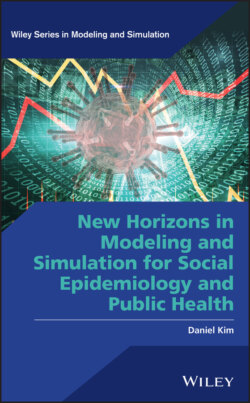Читать книгу New Horizons in Modeling and Simulation for Social Epidemiology and Public Health - Daniel Kim - Страница 29
2.5 Structure of this Book
ОглавлениеIn this introductory section (Part I), Chapter 1 defines the social determinants of health, discusses conventional approaches for studying them, and indicates the methodological limitations in identifying their impacts and comments on the public health significance of addressing the social determinants of health. In Chapter 2, we have provided a rationale and overview of current concepts and methods for applying two major sets of analytical tools, ABM and MSM, considered within a larger toolkit of modeling and simulation approaches, to study these social determinants.
In the next section, Part II (Chapters 3–6), we focus on conceptual and empirical applications of ABM to help “unpack” our understanding of the social determinants of health. It consists of four chapters providing an overview of current concepts and methods used for ABM and provides a state‐of‐the‐art, critical synthesis of the ABM evidence base both in the social sciences and in social epidemiology on the social determinants of health to inform future public health research and practice.
Chapter 3 reviews the key terms for agent‐based models in practitioner language, highlights ABM methods to assess the social determinants of health at a population level, discusses applications for studying the social determinants of health and novel extensions of this methodology, and provides an illustrative example. Chapter 4 gives detailed examples of empirically powerful applications of ABM in the social sciences, including a foundation to inform the more recent ABM evidence on the social determinants of health that are reviewed in the subsequent chapter. This body of evidence is explored and grouped into three key areas: neighborhood research (e.g. residential preferences), research on scaling laws in social systems, and anthropological models. Chapter 5 reviews the current evidence on the applications of ABM in social epidemiology and public health to better understand the impacts of the social determinants of health. This evidence is explored and grouped into three key areas: health disparities, obesity, and tobacco control. Several examples of public health applications of ABM including for modeling obesity and tobacco use are introduced. These include models that explore the effects of social influence on obesity dynamics (Hammond and Ornstein 2014), models of residential segregation and obesity disparities (Auchincloss et al. 2011), and a model examining retail point‐of‐sale interventions for tobacco control (Luke et al. 2017).
Chapter 6 summarizes the evidence highlighted in Chapters 4 and 5 and past public policy translation of this evidence and discusses the apparent evidence gaps that, if addressed, would advance the ABM field of inquiry for modeling and “unpacking” the social determinants of health.
Part III (Chapters 7–10) analogously focuses on conceptual and empirical applications of MSM to simulate and thus enhance our understanding of the impacts of the social determinants of health. It provides an overview of the current concepts and methods used for MSM and gives a rich synthesis of the MSM evidence base both in the social sciences and in the field of public health on the social determinants of health.
Chapter 7 reviews the key terms using MSM in practitioner language, highlights microsimulation modeling methods to assess the social determinants of health at a population level, discusses applications for studying the social determinants of health and novel extensions of this methodology, and provides an illustrative example. Chapter 8 reviews the current evidence on the applications of MSM in the social sciences and gives a foundation to inform the more recent MSM evidence on the social determinants of health reviewed in the subsequent chapter. Chapter 9 systematically reviews the current evidence on the applications of MSM to better understand the impacts of the social determinants of health. For example, the chapter describes published examples of applications of MSM including projections of the economic cost savings and population health benefits that would occur if the WHO's recommendations on the social determinants of health were to be adopted in Australia and the impacts on mortality burden of modifying US federal income tax policies based on recent proposals. This chapter also highlights some MSM applications to the study of health care policies, disease microsimulation, and health behavior‐related policies.
Chapter 10 summarizes the evidence presented in Chapters 8 and 9, comments on public policy translation of some of this evidence, and discusses current evidence gaps that, if filled, could move the MSM field toward a richer understanding of the social determinants of health.
We conclude the book with Part IV, Chapter 11, by discussing the future directions for research using ABM and microsimulation modeling and simulation, including the convergence of aspects of both ABM and MSM into the same analyses. It also comments on facilitators and constraints for the continued emergence of these forms of modeling and simulation and casts light on the potential policy implications of findings from these more complex and integrative models.
